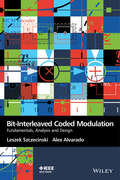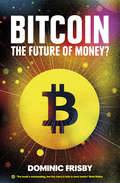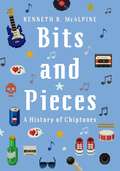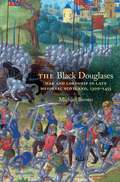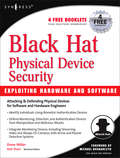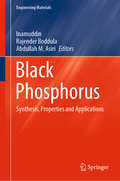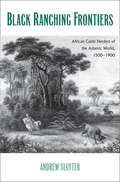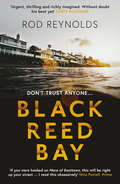- Table View
- List View
Bit-Interleaved Coded Modulation: Fundamentals, Analysis and Design (Wiley - IEEE)
by Leszek Szczecinski Alex AlvaradoPresenting a thorough overview of bit-interleaved coded modulation (BICM), this book introduces the tools for the analysis and design of BICM transceivers. It explains in details the functioning principles of BICM and proposes a refined probabilistic modeling of the reliability metrics–the so-called L-values–which are at the core of the BICM receivers. Alternatives for transceiver design based on these models are then studied. Providing new insights into the analysis of BICM, this book is unique in its approach, providing a general framework for analysis and design, focusing on communication theoretic aspects of BICM transceivers. It adopts a tutorial approach, explains the problems in simple terms with the aid of multiple examples and case studies, and provides solutions using accessible mathematical tools. The book will be an excellent resource for researchers in academia and industry: graduate students, academics, development engineers, and R & D managers. Key Features: Presents an introduction to BICM, placing it in the context of other coded modulation schemes Offers explanations of the functioning principles and design alternatives Provides a unique approach, focusing on communication theory aspects Shows examples and case studies to illustrate analysis and design of BICM Adopts a tutorial approach, explaining the problems in simple terms and presenting solutions using accessible mathematical tools
Bitcoin: The Future of Money?
by Dominic FrisbyFollowing the economic crisis of 2008, the website ‘bitcoin.org’ was registered by a mysterious computer programmer called Satoshi Nakamoto. A new form of money was born: electronic cash. Does Bitcoin have the potential to change how the world transacts financially? Or is it just a passing fad, even a major scam?In Bitcoin: The Future of Money?, MoneyWeek’s Dominic Frisby's explains this controversial new currency and how it came about, interviewing some of the key players in its development while casting light on its strange and murky origins, in particular the much-disputed identity of Nakamoto himself. Economic theory meets whodunnit mystery in this indispensable guide to one of the most divisive innovations of our time.
Biting the Hands that Feed Us: How Fewer, Smarter Laws Would Make Our Food System More Sustainable
by Baylen J. LinnekinThis volume introduces readers to the perverse consequences of many food rules. Some of these rules constrain the sale of “ugly” fruits and vegetables, relegating bushels of tasty but misshapen carrots and strawberries to food waste. Other rules have threatened to treat manure—the lifeblood of organic fertilization—as a toxin. Still other rules prevent sharing food with the homeless and others in need. There are even rules that prohibit people from growing fruits and vegetables in their own yards.
Bits and Pieces: A History of Chiptunes
by Kenneth B. McAlpineBits and Pieces tells the story of chiptune, a style of lo-fi electronic music that emerged from the first generation of video game consoles and home computers in the late 1970s and early 1980s. Through ingenuity and invention, musicians and programmers developed code that enabled the limited hardware of those early 8-bit machines to perform musical feats that they were never designed to achieve. In time, that combination of hardware and creative code came to define a unique 8-bit sound that imprinted itself on a generation of gamers. For a new generation of musicians, this music has currency through the chipscene, a vibrant musical subculture that repurposes obsolete gaming hardware. It's performative: raw and edgy, loaded with authenticity and driven by a strong DIY ethic. It's more punk than Pac-Man, and yet, it's part of that same story of ingenuity and invention; 8-bit hardware is no longer a retired gaming console, but a quirky and characterful musical instrument. Taking these consoles to the stage, musicians fuse 8-bit sounds with other musical styles - drum'n'bass, jungle, techno and house - to create a unique contemporary sound. Analyzing musical structures and technological methods used with chiptune, Bits and Pieces traces the simple beeps of the earliest arcade games, through the murky shadows of the digital underground, to global festivals and movie soundtracks.
Bits on Chips
by Harry VeendrickThis book provides readers with a broad overview of integrated circuits, also generally referred to as micro-electronics. The presentation is designed to be accessible to readers with limited, technical knowledge and coverage includes key aspects of integrated circuit design, implementation, fabrication and application. The author complements his discussion with a large number of diagrams and photographs, in order to reinforce the explanations. The book is divided into two parts, the first of which is specifically developed for people with almost no or little technical knowledge. It presents an overview of the electronic evolution and discusses the similarity between a chip floor plan and a city plan, using metaphors to help explain concepts. It includes a summary of the chip development cycle, some basic definitions and a variety of applications that use integrated circuits. The second part digs deeper into the details and is perfectly suited for professionals working in one of the semiconductor disciplines who want to broaden their semiconductor horizon.
BITS & PIECES C: A History of Chiptunes
by Kenneth B. McAlpineBits and Pieces tells the story of chiptune, a style of lo-fi electronic music that emerged from the first generation of video game consoles and home computers in the late 1970s and early 1980s. Through ingenuity and invention, musicians and programmers developed code that enabled the limited hardware of those early 8-bit machines to perform musical feats that they were never designed to achieve. In time, that combination of hardware and creative code came to define a unique 8-bit sound that imprinted itself on a generation of gamers. For a new generation of musicians, this music has currency through the chipscene, a vibrant musical subculture that repurposes obsolete gaming hardware. It's performative: raw and edgy, loaded with authenticity and driven by a strong DIY ethic. It's more punk than Pac-Man, and yet, it's part of that same story of ingenuity and invention; 8-bit hardware is no longer a retired gaming console, but a quirky and characterful musical instrument. Taking these consoles to the stage, musicians fuse 8-bit sounds with other musical styles - drum'n'bass, jungle, techno and house - to create a unique contemporary sound. Analyzing musical structures and technological methods used with chiptune, Bits and Pieces traces the simple beeps of the earliest arcade games, through the murky shadows of the digital underground, to global festivals and movie soundtracks.
The Bitter Gourd Genome (Compendium of Plant Genomes)
by Chittaranjan Kole Hideo Matsumura Tusar Kanti BeheraThis book focusing on the bitter gourd genome is the first comprehensive compilation of knowledge on the botany, cytogenetical analysis, genetic resources and diversity, traditional breeding, tissue culture and genetic transformation, whole genome sequencing and comparative genomics in the Cucurbitaceae family. It discusses the biochemical profile of the bioactives present in this horticultural crop, used both as a vegetable and as a medicine, and also addresses sex determination in bitter gourd. Written by respected international experts, the book is useful to students, teachers and scientists in academia, as well as seed companies and pharmaceutical industries.
Bitterness: Perception, Chemistry and Food Processing (Institute of Food Technologists Series)
by Michel Aliani Michael N. EskinThe increasing demand for healthy foods has resulted in the food industry developing functional foods with health-promoting and/or disease preventing properties. However, many of these products bring new challenges. While drugs are taken for their efficacy, functional foods need to have tastes that are acceptable to consumers. Bitterness associated with the functional foods is one of the major challenges encountered by food industry today and will remain so in years to come. This important book offers a thorough understanding of bitterness, the food ingredients that cause it and its accurate measurement. The authors provide a thorough review of bitterness that includes an understanding of the genetics of bitterness perception and the molecular basis for individual differences in bitterness perception. This is followed by a detailed review of the chemical structure of bitter compounds in foods where bitterness may be considered to be a positive or negative attribute. To better understand bitterness in foods, separation and analytical techniques used to identify and characterize bitter compounds are also covered. Food processing can itself generate compounds that are bitter, such as the Maillard reaction and lipid oxidation related products. Since bitterness is considered a negative attribute in many foods, the methods being used to remove and/mask it are also thoroughly discussed.
Bitterness: Perception, Chemistry and Food Processing (Institute of Food Technologists Series)
by Michel Aliani Michael N. EskinThe increasing demand for healthy foods has resulted in the food industry developing functional foods with health-promoting and/or disease preventing properties. However, many of these products bring new challenges. While drugs are taken for their efficacy, functional foods need to have tastes that are acceptable to consumers. Bitterness associated with the functional foods is one of the major challenges encountered by food industry today and will remain so in years to come. This important book offers a thorough understanding of bitterness, the food ingredients that cause it and its accurate measurement. The authors provide a thorough review of bitterness that includes an understanding of the genetics of bitterness perception and the molecular basis for individual differences in bitterness perception. This is followed by a detailed review of the chemical structure of bitter compounds in foods where bitterness may be considered to be a positive or negative attribute. To better understand bitterness in foods, separation and analytical techniques used to identify and characterize bitter compounds are also covered. Food processing can itself generate compounds that are bitter, such as the Maillard reaction and lipid oxidation related products. Since bitterness is considered a negative attribute in many foods, the methods being used to remove and/mask it are also thoroughly discussed.
Bituminous Mixtures and Pavements VI
by A. NikolaidesBituminous Mixtures and Pavements contains 113 accepted papers from the 6th International ConferenceBituminous Mixtures and Pavements (6th ICONFBMP, Thessaloniki, Greece, 10-12 June 2015). The 6th ICONFBMP is organized every four years by the Highway Engineering Laboratory of the Aristotle University of Thessaloniki, Greece, in conjunction with
Bituminous Mixtures and Pavements VII: Proceedings of the 7th International Conference 'Bituminous Mixtures and Pavements' (7ICONFBMP), June 12-14, 2019, Thessaloniki, Greece
by A. F. Nikolaides E. ManthosHighway engineers are facing the challenge not only to design and construct sustainable and safe pavements properly and economically. This implies a thorough understanding of materials behaviour, their appropriate use in the continuously changing environment, and implementation of constantly improved technologies and methodologies. Bituminous Mixtures and Pavements VII contains more than 100 contributions that were presented at the 7th International Conference ‘Bituminous Mixtures and Pavements’ (7ICONFBMP, Thessaloniki, Greece 12-14 June 2019). The papers cover a wide range of topics: - Bituminous binders- Aggregates, unbound layers and subgrade- Bituminous mixtures (Hot, Warm and Cold)- Pavements (Design, Construction, Maintenance, Sustainability, Energy and environment consideration)- Pavement management- Pavement recycling- Geosynthetics- Pavement assessment, surface characteristics and safety- Posters Bituminous Mixtures and Pavements VII reflects recent advances in highway materials technology and pavement engineering, and will be of interest to academics and professionals interested or involved in these areas.
Bituminous Mixtures and Pavements VIII
by A. F. Nikolaides E. ManthosBituminous Mixtures and Pavements VIII contains 114 papers as presented at the 8th International Conference ‘Bituminous Mixtures and Pavements’ (8th ICONFBMP, 12-14 June 2024, Thessaloniki, Greece). The contributions reflect the research and practical experience of academics and practicing engineers from thirty-four (34) different countries, and cover a wide range of topics:Session I: Bitumen, Modified binders, Aggregates, and SubgradeSession II: Bituminous mixtures (Design, Construction, Testing, Performance)Session III: Pavements (Design, Construction, Maintenance, Sustainability, Energy and Environmental consideration)Session IV: Pavement management and GeosyntheticsSession V: Pavement recyclingSession VI: Pavement surface characteristics, Pavement performance monitoring, SafetySession VII: Biomaterials in pavement engineeringSession VIII: Prediction models of pavement performanceBituminous Mixtures and Pavements VIII covers recent advances in highway materials technology and pavement engineering, and will be of interest to scientists and professionals involved or interested in these areas.The ICONFBMP-conferences have been organized every four years since 1992. This 8th conference was jointly organized by: Laboratory of Highway Engineering, Aristotle University of Thessaloniki, Greece; Built Environment Research Institute (BERI), University of Ulster, UK; University of Texas San Antonio (UTSA), USA; Laboratory for Advanced Construction Technology (LACT), Technological Institute of Iowa, USA; Technological University of Delft (TUDelft), The Netherlands, and University of Antwerp, (UA), Belgium.
Bituminous Mixtures and Pavements VIII
Bituminous Mixtures and Pavements VIII contains 114 papers as presented at the 8th International Conference ‘Bituminous Mixtures and Pavements’ (8th ICONFBMP, 12-14 June 2024, Thessaloniki, Greece). The contributions reflect the research and practical experience of academics and practicing engineers from thirty-four (34) different countries, and cover a wide range of topics:Session I: Bitumen, Modified binders, Aggregates, and SubgradeSession II: Bituminous mixtures (Design, Construction, Testing, Performance)Session III: Pavements (Design, Construction, Maintenance, Sustainability, Energy and Environmental consideration)Session IV: Pavement management and GeosyntheticsSession V: Pavement recyclingSession VI: Pavement surface characteristics, Pavement performance monitoring, SafetySession VII: Biomaterials in pavement engineeringSession VIII: Prediction models of pavement performanceBituminous Mixtures and Pavements VIII covers recent advances in highway materials technology and pavement engineering, and will be of interest to scientists and professionals involved or interested in these areas.The ICONFBMP-conferences have been organized every four years since 1992. This 8th conference was jointly organized by: Laboratory of Highway Engineering, Aristotle University of Thessaloniki, Greece; Built Environment Research Institute (BERI), University of Ulster, UK; University of Texas San Antonio (UTSA), USA; Laboratory for Advanced Construction Technology (LACT), Technological Institute of Iowa, USA; Technological University of Delft (TUDelft), The Netherlands, and University of Antwerp, (UA), Belgium.
Bivalve Molluscs: Biology, Ecology and Culture
by Elizabeth GoslingBivalve Molluscs is an extremely comprehensive book covering all major aspects of this important class of invertebrates. As well as being an important class biologically and ecologically, many of the bivalves are fished and cultured commercially (e.g. mussels, oysters, scallops and clams) in a multi-billion dollar worldwide industry. Elizabeth Gosling who has a huge wealth of research, teaching and hands on experience working with bivalves, has written a landmark book that will stand for many years as the standard work on the subject. Chapters in Bivalve Molluscs cover morphology, ecology, feeding, reproduction, settlement and recruitment, growth, physiology, fisheries, aquaculture, genetics, diseases and parasites, and public health issues. A full understanding of many of these aspects is vital for all those working in bivalve fisheries and culture. An essential purchase for anyone concerned with this important class of animals, copies of Bivalve Molluscs should be on the shelves of biologists, ecologists, environmental scientists, fisheries scientists and personnel within the aquaculture industry. Copies of the book should be available in all libraries and research establishments where these subjects are studied or taught. Elizabeth Gosling is based at the Galway-Mayo Institute of Technology, Galway, Ireland.
Black-body Radiative, Thermodynamic, and Chromatic Functions: Tables In Finite Spectral Ranges
by Anatoliy I. Fisenko Vladimir F. LembergThis book provides detailed calculated values for the thermal radiative and thermodynamic functions of black-body radiation in finite spectral ranges. The results are presented in tabular form. The areas of thermal power generation, infrared medical diagnostics, solar power and nuclear generation, and astrophysics are included. A range of the thermal radiative and thermodynamic functions are calculated by the authors in the finite frequency/wavenumber/wavelength intervals at different temperatures. This book also contains the tables of the chromaticity coordinates and RGB parameters calculated for different color spaces (Rec.709 (HDTV), sRGB, Adobe RGB). A number of the optimization problems is formulated and solved for various thermal black-body radiative and thermodynamic functions in a finite range of frequencies.
Black cumin (Food Bioactive Ingredients)
by Mohamed Fawzy RamadanRecent developments in the field of nutrition have led to increased interest in herbs and medicinal plants as phytochemical-rich sources for functional food, nutraceuticals, and drugs. As research sheds light on the therapeutic potential of various bioactive phytochemicals, the demand for plant extracts and oils has increased. Black cumin or black seeds (Nigella sativa) have particularly widespread nutritional and medicinal applications. In traditional medicine, black seeds are used to manage fatigue and chronic headache. Black seed oil is used as an antiseptic and analgesic remedy and for treatment of joint's pain and stiffness and can be mixed with sesame oil to treat dermatosis, abdominal disorders, cough, headache, fever, liver ailments, jaundice, sore eyes, and hemorrhoids. Thymoquinone, the main constituent in black seed volatile oil, has been shown to suppress carcinogenesis. Black cumin (Nigella sativa) seeds: Chemistry, Technology, Functionality, and Applications presents in detail the chemical composition, therapeutic properties, and functionality of high-value oils, phytochemicals, nutrients, and volatiles of the Nigella sativa seed. Organized by formulation (seeds, fixed oil, essential oil, and extracts), chapters break this seed down into its chemical constituents and explore their role in the development of pharmaceuticals, nutraceuticals, novel food, natural drugs, and feed. Following numerous reports on the health-promoting activities of Nigella sativa, this is the first comprehensive presentation of the functional, nutritional, and pharmacological traits of Nigella sativa seeds and seed oil constituents.
The Black Douglases: War and Lordship in Medieval Scotland 1300–1455
by Michael BrownDuring the century and a half of their power the Black Douglases earned fame as Scotland’s champions in the front line of war against England. On their shields they bore the bloody heart of Robert Bruce, the symbol of their claim to be the physical protectors of the hero-king’s legacy. But others saw the power of these lords and earls of Douglas in a different light. To their critics the Douglases were a force for disorder in the kingdom, lawless, arrogant and violent, whose power rested on coercion and whose defiance of kings and guardians ultimately provoked James II into slaying the Douglas earl with his own hand.Michael Brown analyses the rise and fall of this family as the dominant magnates of the south, from the deeds of the Good Sir James Douglas in the service of Bruce to the violent destruction of the Douglas earls in the 1450s. Alongside this study of the accumulation and loss of power by one of the great noble houses, The Black Douglases includes a series of thematic examinations of the nature of aristocratic power. In particular these emphasise the link between warfare and political power in southern Scotland during the fourteenth century. For the Black Douglases, war was not just a patriotic duty but the means to power and fame in Scotland and across Europe.
Black Friday (Mira Ser. #7)
by Alex KavaSILENCE. SMOKE. Then the SCREAMING begins. As suicide bombers strike at the heart of America, FBI profiler Maggie O’Dell faces the toughest, deadliest case of her career. Sifting through the debris for answers, O’Dell discovers that worse is yet to come, with more attacks imminent – and the consequences nimaginable.
Black Hat Physical Device Security: Exploiting Hardware and Software
by Drew MillerBlack Hat, Inc. is the premier, worldwide provider of security training, consulting, and conferences. In Black Hat Physical Device Security: Exploiting Hardware and Software, the Black Hat experts show readers the types of attacks that can be done to physical devices such as motion detectors, video monitoring and closed circuit systems, authentication systems, thumbprint and voice print devices, retina scans, and more. The Black Hat Briefings held every year in Las Vegas, Washington DC, Amsterdam, and Singapore continually expose the greatest threats to cyber security and provide IT mind leaders with ground breaking defensive techniques. There are no books that show security and networking professionals how to protect physical security devices. This unique book provides step-by-step instructions for assessing the vulnerability of a security device such as a retina scanner, seeing how it might be compromised, and taking protective measures. The book covers the actual device as well as the software that runs it. By way of example, a thumbprint scanner that allows the thumbprint to remain on the glass from the last person could be bypassed by pressing a "gummy bear" piece of candy against the glass so that the scan works against the last thumbprint that was used on the device. This is a simple example of an attack against a physical authentication system.First book by world-renowned Black Hat, Inc. security consultants and trainersFirst book that details methods for attacking and defending physical security devicesBlack Hat, Inc. is the premier, worldwide provider of security training, consulting, and conferences
Black Phosphorus: Synthesis, Properties and Applications (Engineering Materials)
by Inamuddin Abdullah M. Asiri Rajender BoddulaThis book exhibits novel semiconductor black phosphorous (BP) materials that are developed beyond other 2D materials (graphene and TMDs). It accurately reviews their manufacture strategies, properties, characterization techniques and different utilizations of BP-based materials. It clarifies all perspectives alongside down to earth applications which present a future direction in the biomedical, photo, environmental, energy, and other related fields. Hence, the sections accentuate the basic fundamentals, synthesis, properties, applications, state-of-the-art studies about the BP-based materials through detailed reviews. This book is the result of commitments by numerous experts in the field from various backgrounds and expertise. It will appeal to researchers, scientists and in addition understudies from various teaches, for example, semiconductor innovation, energy and environmental science. The book content incorporates industrial applications and fills the gap between the exploration works in the lab and viable applications in related ventures.
Black Ranching Frontiers: African Cattle Herders of the Atlantic World, 1500-1900 (Yale Agrarian Studies Series)
by Andrew SluyterIn this groundbreaking book Andrew Sluyter demonstrates for the first time that Africans played significant creative roles in establishing open-range cattle ranching in the Americas. In so doing, he provides a new way of looking at and studying the history of land, labor, property, and commerce in the Atlantic world.Sluyter shows that Africans’ ideas and creativity helped to establish a production system so fundamental to the environmental and social relations of the American colonies that the consequences persist to the present. He examines various methods of cattle production, compares these methods to those used in Europe and the Americas, and traces the networks of actors that linked that Atlantic world. The use of archival documents, material culture items, and ecological relationships between landscape elements make this book a methodologically and substantively original contribution to Atlantic, African-American, and agricultural history.
Black Reed Bay (Detective Casey Wray #1)
by Rod ReynoldsWhen a young woman vanishes from an exclusive oceanfront community, Detective Casey Wray’s investigation plunges her into a darkness she could never have imagined ... Breathtaking, unnerving contemporary American Noir.____________________When a young woman makes a distressing middle-of-the-night call to 911, apparently running for her life in a quiet, exclusive beachside neighbourhood, miles from her home, everything suggests a domestic incident.Except no one has seen her since, and something doesn’t sit right with the officers at Hampstead County PD. With multiple suspects and witnesses throwing up startling inconsistencies, and interference from the top threatening the integrity of the investigation, lead detective Casey Wray is thrust into an increasingly puzzling case that looks like it’s going to have only one ending…And then the first body appears…___________________Praise for Rod Reynolds‘Brutal, brilliant and razor sharp. Blood Red City is pure adrenaline rush from the first page to the last’ Chris Whitaker‘Bristling with tension, danger and seamed with the constant threat of violence … Blood Red City confirms Rod Reynolds status as one of the greatest crime talents of his generation’ Tim Baker‘Reynolds is a great scene setter and he is as good at action as he is at the development of Lydia’s character. She is brave, clever, sometimes silly and absolutely credible’ Literary Review‘An outstanding page-turner that ratchets up the tension as it builds via a labyrinthine plot towards a satisfying and well-crafted climax … relevant and at times alarming, Blood Red City slaloms its way through the world of social media, geopolitics and hi-tech innovation with compelling conviction’ G.J. Minett‘Echoes of the fears and worries of a modern world abound here in this pacy and subtle novel’ The Sun‘The creeping tension and mistrust is palpable and there’s an absolutely cracking end reveal’ Shots Magazine
Black Rice: Research, History and Development
by U.K.S KushwahaThe main purpose of this book is to introduce black rice to a wider circle of people. Although there have been research on different aspects of black rice, the information is scattered and not easily accessible to laypersons. The book intends to cover all the aspects of black rice from research, history, to its development. As such, the book will be suitable for both rice researchers and non-professionals who want to know more about this unique rice crop.Black rice, also known as forbidden rice, is packed with high level of nutrients and antioxidants. The antioxidants found in black rice is higher than the blueberries (that contain highest amount of anthocyanins). Black rice is black due to anthocyanin content in the outer layer of its kernel. Legend tells that this rice was consumed only by royals in China and it was expected that this rice would increase life span of the king. Consumption of black rice without approval was hanged. Ordinary individuals were not allowed to consume black rice. Thus this rice is also known as forbidden rice and Emperor’s rice. Now this black heirloom rice is widely available in different parts of the world. Researchers have found that black rice reduce Reactive Oxygen Species (ROS), the free radicals produced in the body which is the cause of many diseases. This rice also reduce diabetes, inflammation, heart attack, allergy and obesity; reduce the growth of cancer, improves digestive system and is panacea of many health problems. Thus this rice is also known as long life rice. Food nutritionists consider black rice as modern super foods. The cultivation method of black rice is similar to general rice cultivation practices. There are many varieties available in black rice which is of different Asian origin but Chinese black rice is the most famous among them. Black rice has a wide range of applications because its bran is used as a natural food colouring dye, and it is also used to prepare noodles, pasta, porridge, wine etc. This rice takes slightly longer time to cook than widely available white rice. In modern era, black rice serve as one of the best food materials available to us to maintain our health with regular physical exercise.
The Black Sea: Physical, Environmental and Historical Perspectives (Springer Geography)
by Emil Vespremeanu Mariana GolumbeanuThis book underpins the geography of the Black Sea, covering topics such as morphology, morphography, geology, and history of the Black Sea. It also discusses environmental aspects affecting the population in the Black Sea's coastal settlements and looks to the future of the Black Sea region. This book covers a gap in research in the field of world regional geography of the Black Sea by providing a comprehensive methodology and terminology to readers, students and teachers in the field.
Black Sea Energy Resource Development and Hydrogen Energy Problems (NATO Science for Peace and Security Series C: Environmental Security)
by Ayfer Veziroğlu and Marat TsitskishviliNATO Advanced Research Workshop “The Black Sea: Strategy for Addressing its Energy Resource Development and Hydrogen Energy Problems” was held in order to evaluate the Black Sea Region’s environment, discuss the ways and means of protecting it, and to evaluate the methods of production of the energy carrier, hydrogen. Papers presented at the workshop, proposed various methods of hydrogen production from the hydrogen sulfide, from marine macro algae and other bacteria, storage and utilization of hydrogen, oil spills and pollutants in the Black Sea, degradation of the sea and the land around the region, and ways and means of protecting the environment.The workshop participants unanimously expressed the need to establish close cooperation amongst the Region’s countries regarding the development of its energy resources, and at the same time protecting its environment. These recommendations have been put together in the Batumi Manifesto.This book entitled “Black Sea Energy Resource Development and Hydrogen Energy Problems” puts together the papers presented at the workshop, starting with the Batumi Manifesto. This valuable volume should be in the libraries of all the scientists, engineers, environmentalists, economists and decision makers involved in the development of the Black Sea Region and in the introduction of clean and abundant Hydrogen Energy.
